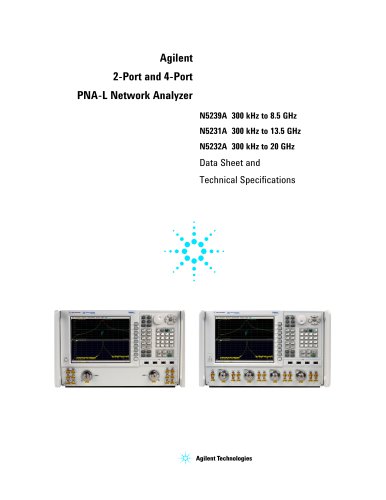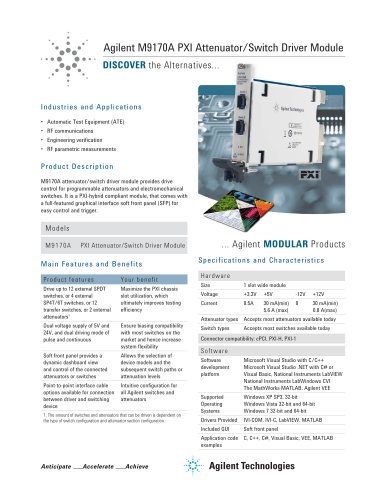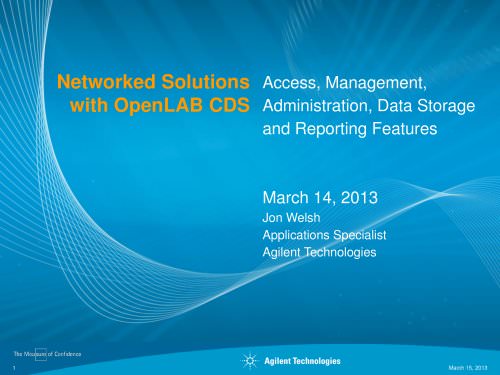
Catalog excerpts
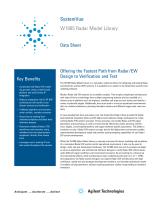
SystemVue W1905 Radar Model Library Data Sheet Key Benets • Accelerates the Radar/EW modeling process using a model-based platform and multi-format IP integration • Reduces integration risk for RF-DSP architectures with earlier crossdomain analysis and verification • Validates algorithms and systems under realistic, complex scenarios • Saves time by starting from validated templates and block-level reference designs • Generates wideband Radar/ EW waveforms and scenarios using wideband test and measurement equipment, directly from simulations • Leverages user’s existing IP and test assets throughout the process Offering the Fastest Path from Radar/EW Design to Verication and Test The W1905 Radar Model Library is a simulation reference library for designing and testing Radar and electronic warfare (EW) systems. It is available as an option to the SystemVue system-level modeling software. Modern Radar and EW systems are incredibly complex. They employ complicated architectures with state-of-the-art technology from multiple engineering domains and are installed on a diverse array of platforms such as airplanes, satellites and ships to track, detect and identify a variety of potential targets. Additionally, they must work in a host of operational environments that can include interference, jamming/deception clutters and different target radar cross sections. To save development time and reduce cost, the SystemVue Radar Library provides 92 highlyparameterized simulation blocks and 93 higher-level reference design workspaces to create working Radar/EW system scenarios. These scenarios can include Radar and EW signal generation and processing, as well as environmental effects like clutter, jamming, interference, targets, and simulated platform and target hardware specific parameters. The ability to simulate not only a Radar/EW system concept, but the full deployment environment enables unprecedented development speed and provides rapid prototyping capabilities for any Radar/ EW system development. While the W1905 Radar Model Library is primarily structured for direct modeling and simulation of a conceptual Radar/EW system and its operational environment, it also can be used to design, verify and test development hardware. The W1905 block set and its example workspaces serve as algorithmic and architectural reference designs to verify Radar/EW performances under different signal conditions and environment scenarios. By accounting for a diverse set of environmental effects, while maintaining an open modeling environment (.m, C++, VHDL, test equipment), the Radar system designer can explore Radar/EW architectures with high confidence, rapidly test and prototype development hardware, and simulate operational results in multiple concept operations, without requiring expensive outdoor range testing or hardware simulators.
Open the catalog to page 1
The "scenario framework" simulation technique can model any system, from sta- tionary monostatic ground-based systems to more complex multistatic and phased-array systems, including Multiple-Input Multiple- Output (MIMO) Radar. • The modeling framework supports motion of the Radar transmit and receive platforms, as well as multiple targets, in an earth-centered inertial (ECI) frame • Multiple antenna arrays can be setup in the framework for different systems • Sophisticated Radar/EW scenarios, together with complex target modelling, A simulation example using the scenario framework is shown...
Open the catalog to page 2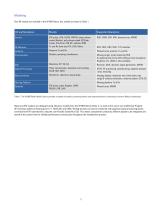
Modeling Over 90 models are included in the W1905 library. Key models are listed in Table 1. Supported Operations DDS, UWB, SFR, SAR, phased array, MIMO CW pulse, LFM, NLFM, FMCW, binary phase coded (Barker), poly phase coded (ZCCode, Frank), PolyTime, FSK HP, arbitrary PRN Tx and Rx front-end, PA, LNA, lters Clutters, jamming, interference Moving target, multi-scattering RCS An optional link to the STK software from Analytical Graphics, Inc. (AGI) is also available. Receiver, DOA, dynamic signal generation, DRFM Signal Processing Pulse compression, detection and tracking, CFAR, MTI, MTD...
Open the catalog to page 3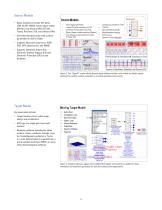
Source Models • Basic waveforms include CW pulse, LFM, NLFM, FMCW, binary phase coded (Barker), poly phase coded (ZCCode, Frank), PolyTime, FSK, and arbitrary PRN • Generated dynamic pulse with runtime • Supports advanced systems for UWB, SAR, SFR, phased array, and MIMO • Supports Electronic Attack (EA), Electronic Warfare Support (ES) and Electronic Protection (EP) for test Source Models Pulse signal generator Linear FM pulse waveform (LFM) Nonlinear FM waveform (NLFM) Binary phase-coded waveform (Barker) Poly phase-coded waveform (Frank, Step frequency source Dynamic Pulse (SignaJX) FMCW...
Open the catalog to page 4
• Support for moving target scenarios Antenna patterns: • Pre-defined: uniform, cosine, parabolic, triangle, circular, CosineSquarePedestal, • User defined: AntennaPatternArray parameter is used for importing from 3D electromagnetic software, such as Scan patterns: • Circular, bi-directional sector scan, uni-directional sector scan, bi-directional raster, uni-directional raster. Antenna Model Antenna Pattern Scan - Raster Figure 4. Antenna simulation models that scan a 3D environment in common patterns are useful for modeling coverage, detection margins and latencies in search, tracking and...
Open the catalog to page 5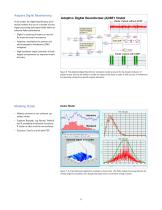
Adaptive Digital Beamforming In the model, the digital beamforming archi- tecture enables the use of a number of array signal processing techniques listed below to enhance Radar performance. • Digital re-steering of beams on receive for improved search occupancy • Adaptive cancellation for jammer and • High-resolution angle estimation of both targets and jammers for improved metric Adaptive Digital Beamformer (ADBFl Model Radar Output without ADBF -n Radar Output with ADBF _ Figure 6. The Adaptive Digital Beamformer simulation model accounts for the dynamic behavior of phased arrays, such...
Open the catalog to page 6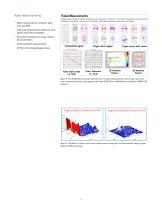
Radar Measurements • Basic measurements: waveform, spec- • Advanced measurements Detection prob- ability, false alarm probability • Parameter estimation for range, velocity • Antenna pattern measurements • 3D Plot in the Range-Doppler plane Radar Measurements Radar Measurements: Basic measurements: Waveform, Spectrum, and SNR. Advanced measurements. Detection probability, False Alarm probability, Parameter Estimation and Antenna Pattern Transmitted signal Target return signal Target return with clutter False Alarm Rate Prob. Detection Figure 8. The W1905 library provides algorithms for...
Open the catalog to page 7All Agilent Technologies - Life Sciences and Chemical catalogs and technical brochures
-
Agilent 280 Series AA Systems
12 Pages
-
Inorganic Standards
40 Pages
-
InfinityLab LC Supplies
148 Pages
-
General Chromatography
164 Pages
-
Sample Preparation (2018/2019)
144 Pages
-
MS500
12 Pages
-
FLAME ATOMIC ABSORPTION SPECTROSCOPY
104 Pages
-
Agilent training
27 Pages
-
AGILENT VACUUM PRODUCTS CATALOG
536 Pages
-
Vacuum Measurement Catalog
44 Pages
-
AGILENT ION Pumps
53 Pages
-
AGILENT DIFFUSION PUMPS
35 Pages
-
AGILENT Rotary Vane Pumps
29 Pages
-
Agilent InfinityLab LC Series
16 Pages
-
3100 fractionator
8 Pages
-
4200 MP-AES
12 Pages
-
Agilent GPC/SEC Solutions
12 Pages
-
Agilent?s biomass solutions
12 Pages
-
X-ray Crystallography
12 Pages
-
Agilent ProPulse NMR System
5 Pages
-
An autosampler like no other
4 Pages
-
Agilent U1450A/U1460A
19 Pages
-
Agilent B1507A
22 Pages
-
Agilent M9703A
16 Pages
-
M8048A ISI Channels
7 Pages
-
Agilent J-BERT M8020A
27 Pages
-
Agilent N8900 Series
10 Pages
-
I/O Hardware
16 Pages
-
Advanced Design System
16 Pages
-
RF & Microwave Attenuators
4 Pages
-
E4980AL Precision LCR Meter
8 Pages
-
FieldFox Handheld Analyzers
8 Pages
-
AFM/SPM Accessories
20 Pages
-
VEE 9.32
24 Pages
-
89600 VSA Software
9 Pages
-
Command Expert
2 Pages
-
E5061B Network Analyzer
8 Pages
-
E5071C ENA Network Analyzers
18 Pages
-
N9038A MXE EMI Receiver
2 Pages
-
N9322C Basic Spectrum Analyzer
10 Pages
-
Digital Multimeters
25 Pages
-
M9361A PXI Downconverter
2 Pages
-
Power Meters and Power Sensors
34 Pages
-
E7515A UXM Wireless Test Set
2 Pages
-
Agilent Power Products
31 Pages
-
E5063A Network Analyzer
8 Pages
-
Leak Detection Catalog
41 Pages
-
Agilent 7820A GC brochure
8 Pages
-
Agilent GC-MSD and QTOF
96 Pages
-
Agilent GC-MSD 5977
39 Pages
-
Agilent Intro BERLIN
24 Pages
-
1290 Infinity Quaternary LC
24 Pages
-
1260 Infinity Bio-inert
26 Pages
Archived catalogs
-
Diffusion Pumps Catalog
37 Pages



































































